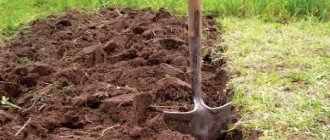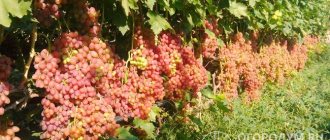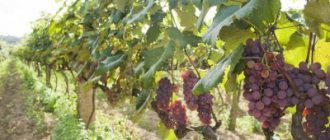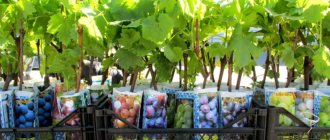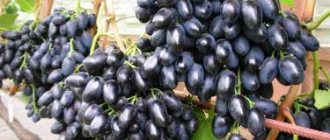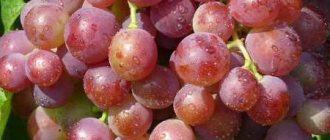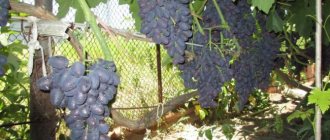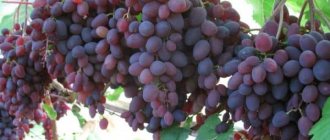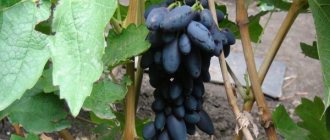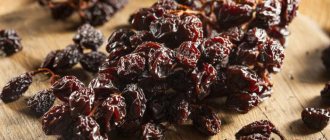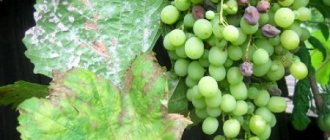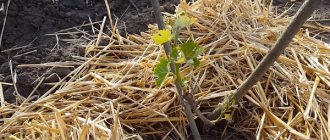Advantages and disadvantages
Advantages:
- The flowers of the plant are bisexual.
- The ripening rate is 75%.
- The brushes are able to remain on the bush for a long time without cracking, and after harvesting they do not lose their presentation for a long time.
- Low susceptibility to diseases and pests.
- Does not require special care or abundant watering.
- Cuttings take root quickly.
- High frost resistance.
- The organoleptic characteristics of the variety are at a decent level.
Flaws:
- Poor moisture tolerance: from excess moisture, the berries begin to crack, attracting swarms of small midges.
- Attracts birds.
- The presence of seeds in the berries, but their presence does not significantly affect the taste of the fruit.
Care
The bushes will grow well if you choose soils with good drainage, rich in humus and peat for planting. Tie the seedlings for stability; maintain a distance between bushes of about 1.5 m.
Between the rows of grape bushes of the Ruslan and Anyuta varieties, you need to leave a gap of about 3 m. This is necessary not only for the normal growth of the vine, but also to prevent pest infestation.
To reduce humidity, you need to regularly ventilate. The variety tolerates drought and frost normally, but in rainy weather it swells, bursts, and the fruit pulp acquires a watery taste.
In general, the variety is considered unpretentious, so novice gardeners will find it easy to care for.
Resistance to mildew and oidium is good, but the condition of the plantings still needs to be monitored very carefully . Signs of fungal infection are the appearance of gray or yellow spots on the leaves. The correct choice of planting site has a direct impact on the survival of the bushes, fruiting and growth of the vine. To ensure that the plants have good immunity, place the vineyard in a sunny, dry part of the plot, in the southwest or south of the house. It is still better to cover the bushes for the winter.
To ensure that the vine forms correctly, make short prunings. The height of the fruiting part should be in the range of 200-310 cm. The flowers are bisexual, so the bushes pollinate independently. In order for the vine to ripen well, you need to leave 2-3 inflorescences per shoot. Ripening is simultaneous on all shoots at once; the clusters can be left on the vine even after reaching maturity (they do not fall off or rot). Read about the Malbec grape variety here.
Main characteristics
Ruslan grapes are good fresh: their fruity taste with light plum notes is ideal for fruit desserts. The variety is also used for making red wine, liqueur, preserves, and jam.
Ripening period
“Ruslan” is classified as an early ripening hybrid. The growing season of the variety lasts about 105 - 120 days: the berries can already be enjoyed in early August, and in cold weather - maximum in the 20th of the last month of summer.
Bush
The bush is very powerful, tall and strong. The vine ripens well and becomes chocolate-colored with dark red nodes; its ripening rate is 72% even with a significant harvest load. Long and massive shoots need support. There are many leaves on the bush, all of them are large in size, round in shape, and bright green in color. Flowers are hermaphrodites.
bunches
The bunches of “Ruslan” amaze with their beauty and volume: each of them is very large, weighing from 0.5 to 1.2 kg. The clusters are moderately dense, without small berries, elongated in the form of a regular oval.
Berries
Fully ripe large and oval berries become deep blue with a blackish tint. Each of them is covered with a whitish coating, easily erased by hand. The weight of the berries ranges from 10 to 20 g.
The thin skin, which absolutely does not interfere with chewing and does not in any way affect the taste of the fruit, protects the dense juicy pulp with two seeds inside each berry. The sugar content is 18 g/100 cm 3 with an acid content of 6.5 g/l.
Taste
The variety has a unique fruity taste with a slight plum tint.
Attention! The Ruslan hybrid contains a lot of useful vitamins (C, B, K, P) and minerals: zinc, magnesium, manganese, cobalt, chromium. Thanks to the combination of the vitamin-mineral complex and organic acids, also included in the chemical composition of the fruit, grapes can be successfully used as a preventive measure and to reduce the intensity of unpleasant symptoms of anemia, kidney and bladder diseases.
Reproduction methods
Experienced gardeners use three methods of propagating Ruslan grapes:
- Planting seedlings with roots. The most common method of propagation is based on the germination of cuttings taken from mature vines. In early spring, with the onset of warmth, Ruslan seedlings are planted with unopened buds. In mid-May, awakened planting material with leaves is used. Ruslan seedlings can be planted in the fall. This is usually done in October so that rooting occurs before the onset of frost. Immediately after planting, the Ruslan grape seedling is protected from the cold overnight.
- Grafting cuttings onto an old vine. The propagation method is complex and is suitable for experienced gardeners. If there is a vine growing in the yard, but you don’t like the variety, you can grow Ruslan on its roots by grafting. Cuttings are suitable with awakened and dormant buds. The Ruslan variety is grafted in spring and autumn, when the days are warm.
- The simplest method of propagation is to dig in a long lash of mature Ruslan vine in the summer. The soil in this place is constantly kept moist so that the shoot takes root. The next season, or better yet, after two years, the vine is cut off from the main grape bush. Ruslan's seedling continues to grow on its own roots.
For an experienced gardener, propagating Ruslan grapes is a simple matter. Use any of three methods. It is better for beginning winegrowers to buy a ready-made seedling or use the method of burying the vine in the ground.
Features of cultivation
“Ruslan” is not particularly picky. A sunny, open, southern area, any soil, organic or mineral fertilizer and the absence of excess moisture are ideal for it: excess moisture can cause the fruits to crack.
Bush pruning
Pruning the bush is a prerequisite for high yields. The maximum permissible number of shoots on an adult bush is 35, each of which has 6 eyes. Typically, winegrowers have to cut off 10 eyes from each shoot. Before the procedure, it would also be a good idea to remove dried berries, branches, and leaves.
Diseases and pests
Although the hybrid exhibits good resistance to diseases (mildew and oidium), preventive treatment in the spring, before flowering, still will not hurt. A 1% solution of Bordeaux mixture or a 3% solution of copper sulfate will help prevent the development of diseases. But if they are available, it is better to resort to other fungicides: Delan, Raek, Skor, Ridomil Gold, Dinali and others.
Birds will cause the owner of the Ruslan the most trouble. The best option is to fence the bush with a strong mesh with small cells. However, fishing nets will become a real trap for birds, and the winegrower risks causing the death of many bird lives.
Important! Regular inspection of bushes for signs of disease will help to promptly identify threatening symptoms and provide timely assistance to the plant, which will help prevent the spread of the disease to the entire bush.
Wintering
It is worth covering the hybrid for the winter only in those regions where the temperature drops to -15ºС, -20ºС. The grape shoots are removed from the support and laid out on the ground. On top - spruce branches, shields, film or a 10-centimeter layer of earth. It is also safer to cover the trunk of the bush with a thick layer of sawdust or straw. And after a snowfall, it would be a good idea to cover the plant with fluffy snow.
Harvest storage
“Ruslan” is a suitable variety for sale. It is not afraid of transportation, it is stored for a long time without losing its presentation.
Regions
Initially, the variety, bred in warm Ukraine, successfully acclimatized in the southern regions of Russia, Kazakhstan and Moldova. But breeders assure that the hybrid takes root well in regions with a temperate climate. Currently, the variety is being adapted to the conditions of the Middle Zone, the Urals and even Siberia. And the first results are very successful, but where the thermometer drops below -15ºC in winter, the plant must be covered.
Tips for proper landing
Fertile soil is only half the requirement for successful grape growing. Ruslan needs good drainage, ensuring the free flow of excess moisture from the root system.
Attention! When planting grapes in lowlands, take into account the location of groundwater. If the layers lie above 2 m from the surface of the earth, it is better to find a place on a hill for Ruslan seedlings.
Preparing a hole for planting consists of the following steps:
- For a grape seedling, dig a hole 80 cm wide, deep and long.
- Drainage is placed first at the bottom of the hole. Crushed stone, small stone or gravel will do. The drainage is covered with three buckets of humus mixed with fertile soil and peat.
- The pit is left to settle for at least 14 days until the day the grape seedlings are planted. During this time, the soil will shrink.
- A Ruslan seedling is selected with a strong root system and two eyes.
- After shrinking, more soil is added to the hole, laying it out in a heap. You can add 1 tbsp. l. mineral fertilizer.
- The seedling is lowered into the hole, bending the roots to the side, and covered with earth up to the neck.
After planting the grapes, 3 buckets of water are poured into the hole. After absorption, the soil will still sag. If a peg is driven into the center of the hole, the grape seedling is tied for stability. The soil in the hole is covered with mulch. Sawdust or peat will do.
Comparison with analogues
The most popular early varieties with dark berries are “Kodryanka”, “Viking”, “Baikonur”, “Charlie”, “Rada”, “Furshetny”, “Cardinal”. “Ruslan” surpasses most of them in terms of bunch weight: “codrianka”, “rada”, “Charlie”, “buffet”, “cardinal”. The berries of “Ruslan” are also larger than other varieties. However, it is inferior in terms of frost resistance to “Baikonur” and “Charlie”: these varieties are able to survive frosts of -28ºC.
Another comparison of “Ruslan” with other early black varieties:
| Sign | Variety | |||
| Ruslan | Gala | Codrianca | Fun | |
| Ripening period | 105 – 120 days | 110 -115 days | 110 – 120 days | 105 – 110 days |
| Frost resistance | -24С | -22C | -24С | -21C |
| Productivity | Up to 20 kg | Up to 23 kg | Up to 50 kg | 25 – 30 kg |
| Bunches | 0.5 – 1.2 kg | 0.5 – 1.5 kg | 400 g – 1.5 kg | 600 g – 1.5 kg |
| Taste | Plum notes | Sweet and sour, simple | Harmonious | Notes of cherry and plum |
| Color | Dark blue | Dark blue | Dark purple | Dark blue |
| Disease resistance | Average | Above average | Above average | Average |
| Shelf life | 1 – 2 months | 3 months | 3 months | 2 – 3 months |
| Sugar accumulation | 18% | 16,5% | 18 – 19% | 18 – 20 % |
| Acidity | 6.5 g/l | 6 – 8 g/l | 6 – 7 chapters | 6 – 8 g/l |
Photo gallery: Ruslan grapes from breeder Zagorulko
The Ruslan variety is suitable for fresh consumption, for making juices and wines, jellies, marmalade, and raisins
The average weight of a bunch of Ruslan is 700–800 g, and there is practically no pea bunching
The fruits are not prone to shedding and can hang on the vine for a long time without harming themselves.
Photo
Below we will look at photos and reviews about the “Ruslan” variety.
Reviews
All reviews about the “Ruslan” variety are extremely positive, which is another argument for planting it on your site.
“Ruslan’s berries are ripe by the beginning of July. The taste has plum notes. All my friends liked it.” Irina Ivanovna
“Definite plum flavor. The skin of the berries is thin, but easily torn; this does not interfere with eating. The pulp is firm and juicy. There are bones, but only 1-2 pieces.” Ivan
A significant advantage of the “Ruslan” variety is stable fruiting, relative unpretentiousness and good presentation. “Ruslan” is ideal for a beginner in viticulture; he will be able to get good at this variety.
